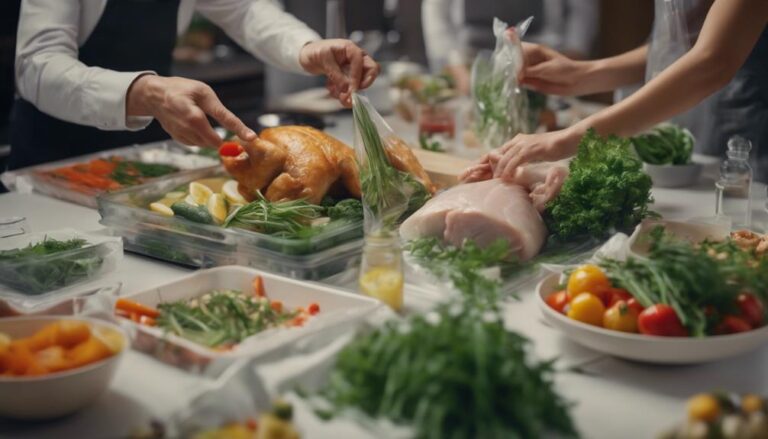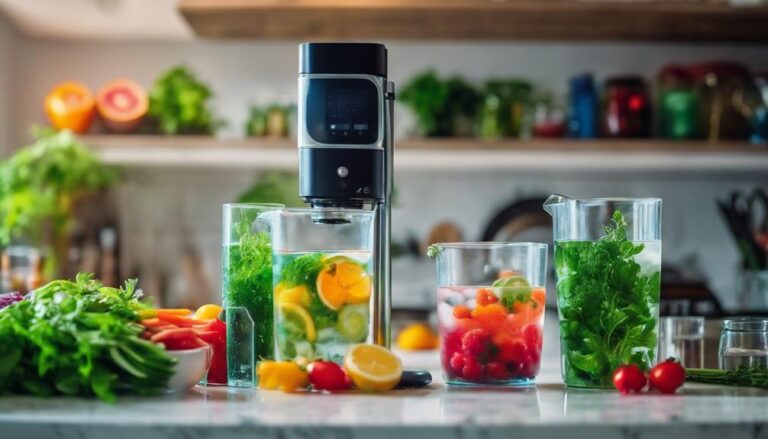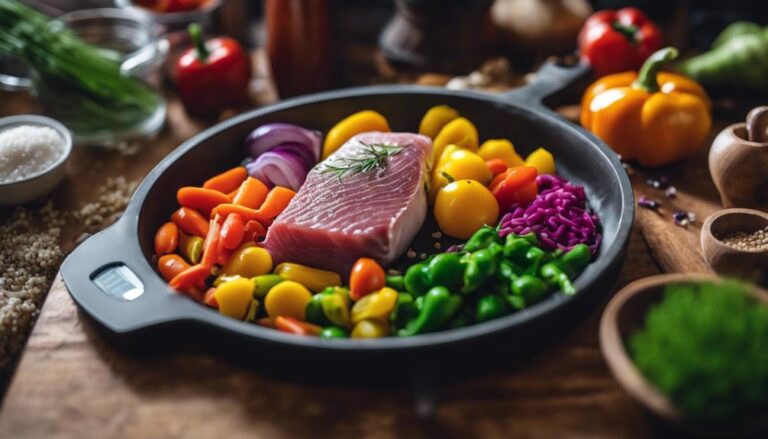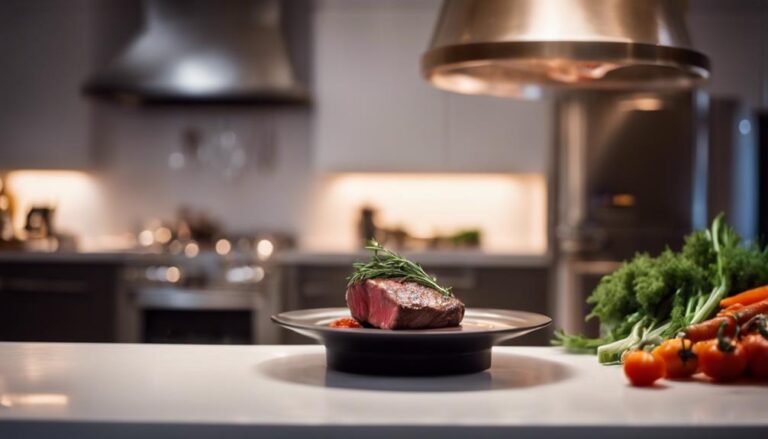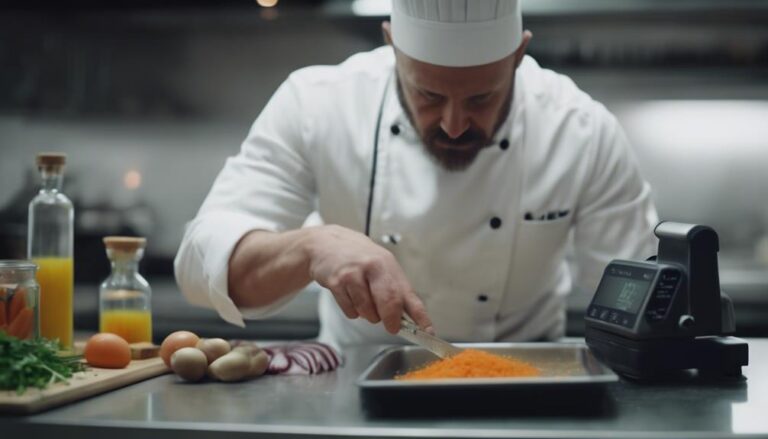Sous Vide Cooking for Weight Loss: A Step-by-Step Guide
Sous vide cooking is a great option for weight loss because it allows you to prepare flavorful meals without extra fats. Start with an immersion circulator and vacuum sealer to control cooking temperatures and retain moisture. Use lean cuts of meat, trim excess fat, and season with herbs and spices instead of high-calorie sauces. Cook meats in vacuum-sealed bags to keep nutrients intact. Portion your meals to manage calorie intake effectively. After cooking, you can freeze leftovers for future meals. By following these steps, you can enjoy healthy, satisfying dishes that align with your weight loss goals, and there's more to explore.
What You Will Learn Here
- Sous vide cooking retains moisture and nutrients, aiding in weight loss by minimizing the need for added fats or oils.
- Precise temperature control ensures consistent cooking, resulting in tender, flavorful meals that satisfy without excess calories.
- Batch cooking with portion control reduces food waste and helps track caloric intake effectively.
- Using lean cuts of meat and seasoning with herbs enhances flavor while keeping caloric content low.
Benefits of Sous Vide Cooking
Harnessing the power of precise temperature control, sous vide cooking helps you retain moisture and nutrients in your meals, making it easier to achieve your weight loss goals. This innovative technique uses vacuum-sealed bags to cook food evenly, eliminating the need for added fats and oils. As a result, you enjoy lower-calorie cooking without sacrificing flavor.
One of the standout benefits of sous vide cooking is the ability to batch cook meals. By preparing larger quantities in advance, you can effectively promote portion control and reduce food waste. This approach supports your weight loss plan by making it simple to grab a healthy meal when you're short on time.
Moreover, cooking at lower temperatures for extended periods enhances the tenderness of lean meats, ensuring that you can savor your dishes without relying on calorie-dense sauces. The consistent results you achieve with sous vide eliminate guesswork, aligning perfectly with your dietary requirements and weight loss objectives.
Essential Tools for Success
To make the most of sous vide cooking and assure your weight loss journey is a success, you'll need some key tools that streamline the process and enhance your results.
First and foremost, an immersion circulator is essential. It provides precise temperature control within a single degree, assuring your meals cook perfectly every time.
Then, invest in a vacuum sealer for sealing food in sous vide bags; this helps retain moisture, flavor, and nutrients during cooking.
Cambro containers are also highly recommended, as they offer better insulation than regular pots, maintaining water temperature efficiently.
To prevent your bags from floating, use binder clips to secure them to the container's side; this assures even cooking throughout.
Additionally, a digital kitchen thermometer is beneficial for monitoring food temperatures, enhancing food safety during cooking and storage.
Preparing Ingredients for Cooking

Preparing your ingredients properly is essential for achieving delicious and healthy results in sous vide cooking.
Start by purchasing fresh ingredients, like whole muscles or bulk meat, which not only saves you money but also guarantees better quality. Trim excess fat and any undesirable parts from the meat to enhance flavor absorption during the cooking process.
Next, cut the meat into portion sizes that align with your meal planning. This helps you control serving sizes and reduces food waste, making it easier to stick to your weight loss goals.
Before you vacuum seal your ingredients, season the meat with your favorite spice rubs, herbs, or marinades. This step infuses the flavors deeply during the sous vide process.
Seasoning and Bagging Techniques
Once you've trimmed and portioned your ingredients, the right seasoning and bagging techniques will elevate your sous vide dishes while keeping them aligned with your weight loss goals.
Start by seasoning your meat with a combination of spice rubs, salt, pepper, and fresh herbs. This enhances flavor without adding calories. For maximum flavor infusion, allow the meat to marinate with the seasoning for at least 30 minutes before bagging.
When it comes to bagging techniques, use high-quality vacuum-sealable bags to prevent air from causing freezer burn and to lock in those delicious flavors.
Consider adding aromatics like garlic, onion, or citrus zest directly into the bag, as they can boost flavor without increasing calorie intake.
Remember to trim excess fat from the meat before seasoning and bagging, as this helps control calorie intake and reduces unwanted grease in the final dish.
Cooking Process Overview
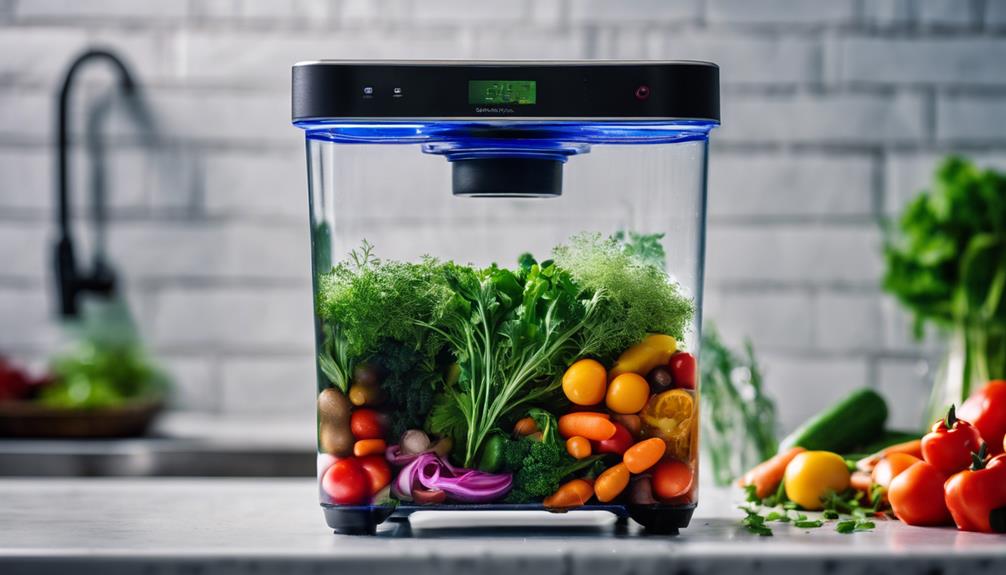
Sous vide cooking immerses your seasoned ingredients in a precisely controlled water bath, ensuring even cooking and moisture retention for healthier meals. By sealing food in vacuum bags, you create a superior environment for cooking that enhances flavors while keeping nutrients intact.
Here's a quick overview of how sous vide works:
| Food Type | Typical Temperature & Cooking Time |
|---|---|
| Tender Cuts of Meat | 130°F, 1-4 hours |
| Vegetables | 185°F, 30-90 minutes |
| Fish | 125°F, 30-60 minutes |
To start, set a precise temperature based on what you're cooking—this guarantees accurate results every time. Cooking times can vary, which allows flexibility in meal planning. Once your dish is ready, if you're not eating it immediately, quickly chill it in an ice bath to maintain quality and food safety.
Freezing and Storing Meals
After mastering the sous vide cooking process, you can extend the life of your meals by freezing and storing them properly.
Start by cooling your sous vide meals in an ice bath. This rapid temperature reduction is vital for food safety, preventing bacterial growth. Once cooled, you can transfer your meals into vacuum-sealed bags. This method allows you to store sous vide meals for up to six months in the freezer while maintaining food quality.
When you're freezing, consider portion sizes. Dividing meals into smaller portions not only makes reheating more convenient but also helps you control calorie intake, which is important for weight loss.
Don't forget to label each bag with its contents and freeze dates. This simple step aids in meal planning and guarantees you use your meals before they spoil.
To reheat your frozen sous vide meals, all you need to do is submerge the vacuum-sealed bags in a water bath at the original cooking temperature. This guarantees that your meals heat evenly, preserving their delicious flavors and textures.
With these tips, you can enjoy the benefits of sous vide cooking even on your busiest days.
Reheating Sous Vide Dishes
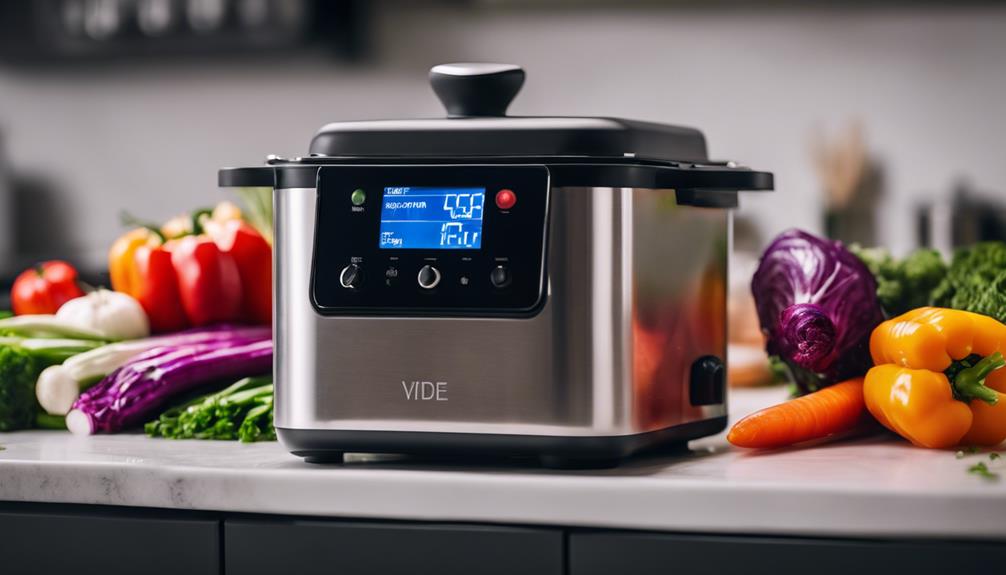
Reheating sous vide dishes is easy and guarantees your meals stay flavorful and perfectly textured. To achieve the best results, use the sous vide method itself. Set your water bath to the original cooking temperature, generally between 130°F to 180°F, depending on the dish. This approach allows for consistent heating without risking overcooking, helping you maintain texture and moisture.
For ideal results, you can reheat sous vide dishes directly in their vacuum-sealed bags. This method not only retains the dish's flavors but also prevents any contamination. If your dish has been frozen, make sure to thaw it in the refrigerator before reheating. This step ensures even heating throughout the meal.
Once your dish is heated, consider searing meats briefly in a hot pan. This final touch enhances the flavor and gives you that restaurant-quality finish you're aiming for.
Tips for Weight Loss Success
Focusing on portion control with sous vide cooking can greatly enhance your weight loss journey by helping you manage your caloric intake more effectively. This method allows you to prepare meals that retain moisture and nutrients, reducing the need for added fats or sauces.
Here are some tips for success:
- Choose Lean Cuts of Meat: Opt for lean cuts to keep calories low while enjoying satisfying meals that support healthy eating.
- Practice Bulk Meal Prep: Preparing meals in bulk can help you avoid unhealthy choices when hunger strikes, ensuring you stick to your weight loss goals.
- Minimize Food Waste: Sous vide cooking allows you to cook only what you need, promoting food waste reduction and consistent portion sizes, which aids in tracking your caloric intake.
Frequently Asked Questions
How Do You Weigh Food Down in Sous Vide?
To weigh food down in sous vide, use food weights, heavy utensils, or water displacement with sous vide bags. Vacuum sealing guarantees temperature accuracy, while stable cooking times enhance flavor infusion and portion control for innovative meal prep.
What Is the First Thing I Should Make in My Sous Vide?
Start with a sous vide steak for incredible tenderness, or try chicken breast infused with herb marinade. You can also experiment with egg custard or dessert pudding for innovative flavors, enhancing your meal prep experience.
How Do You Use Sous Vide Step by Step?
To use sous vide step by step, you'll master sous vide basics: set temperature settings, choose cooking times, infuse flavors, guarantee food safety with sous vide bags, and explore recipe variations for innovative meal prep and nutritional benefits.
What Are the Disadvantages of Sous Vide Cooking?
While sous vide offers precise temperature accuracy and portion control, it requires specialized equipment. Longer cooking times and potential texture differences can limit meal prep options, and if improperly managed, food safety can become a concern.
Conclusion
Incorporating sous vide cooking into your weight loss journey can be both effective and enjoyable.
By understanding the benefits, using the right tools, and mastering preparation and cooking techniques, you can create healthy, delicious meals that support your goals.
Remember to season wisely, store meals properly, and reheat them with care.
With these strategies in mind, you're well on your way to achieving your weight loss objectives while enjoying the process of cooking.






